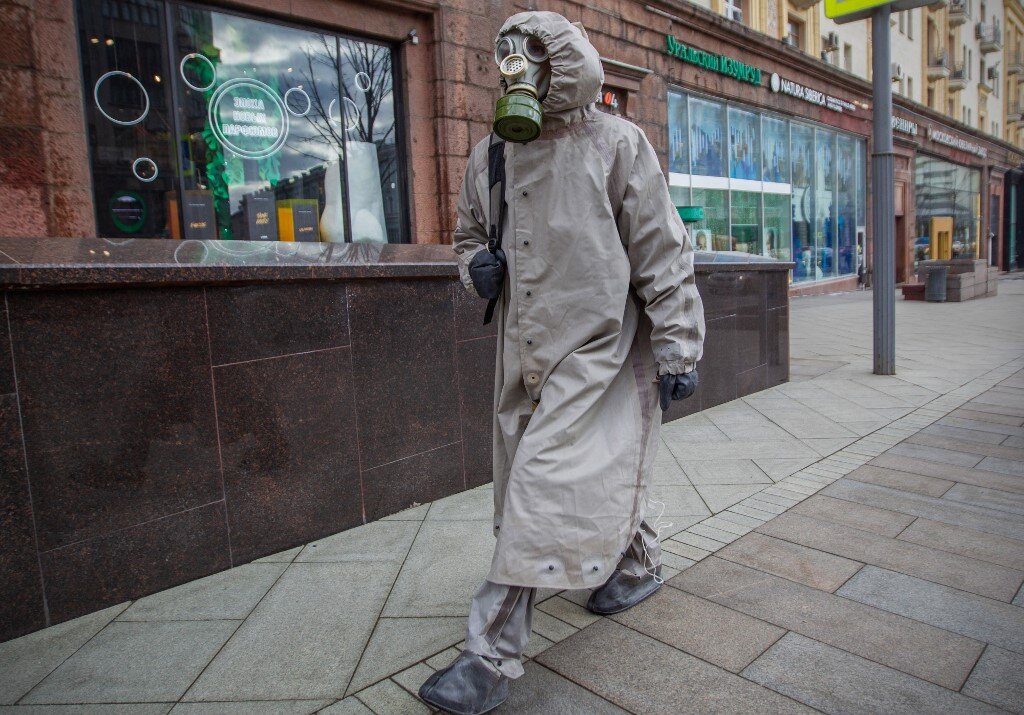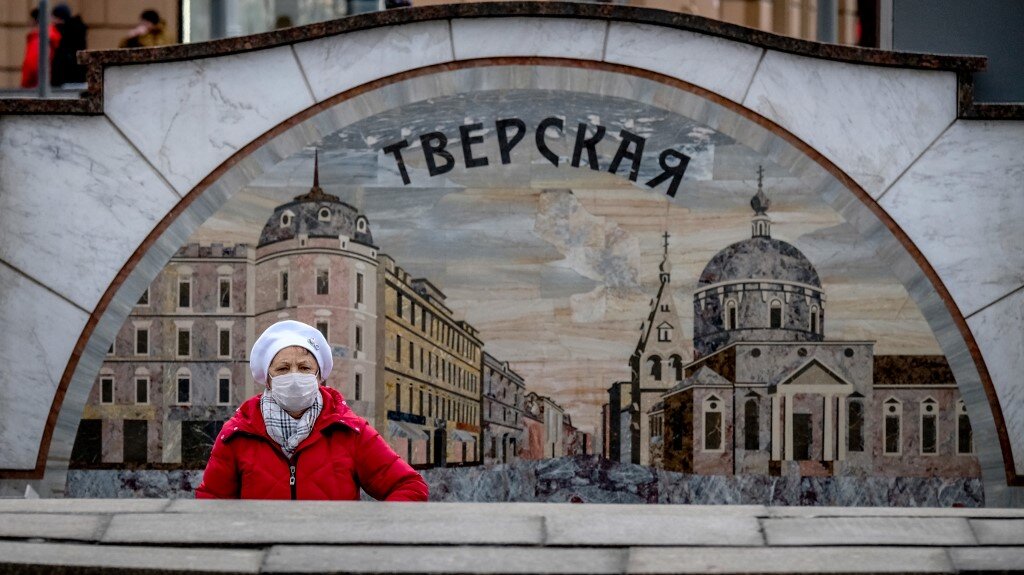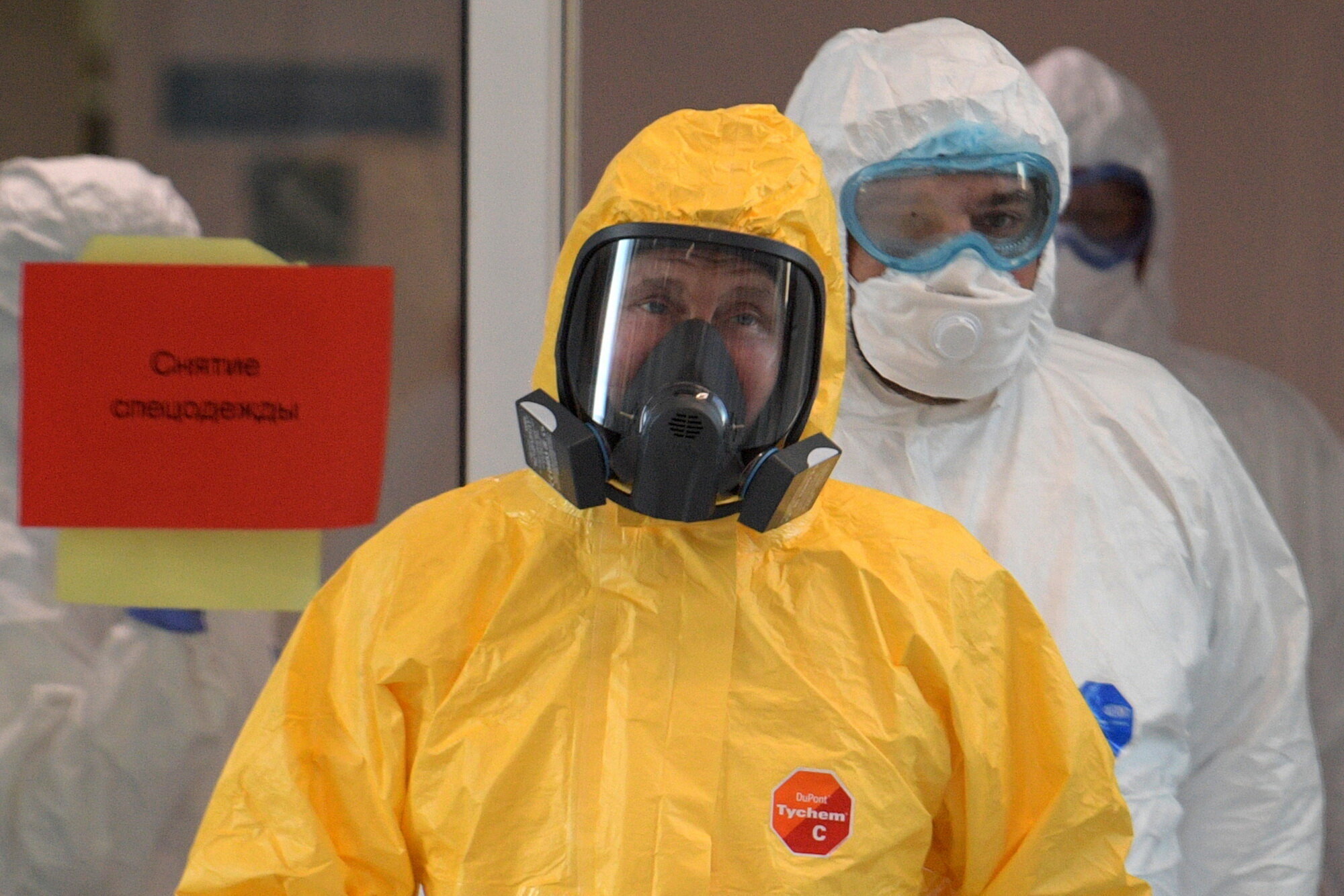After downplaying the COVID-19 pandemic for months, Russia has finally started taking more drastic measures to fight the coronavirus.
The Kremlin has introduced a lockdown in most regions after refusing to do so before.
According to official statistics, the number of COVID-19 cases in Russia has exploded. The country has also performed a large number of coronavirus tests compared to other countries.
However, Russia is still lagging behind major Western countries and China in terms of coronavirus cases and deaths.
But independent doctors and the opposition still argue that official statistics in Russia is unreliable and that the actual figures may be much bigger.
While Russian propaganda touts the Kremlin’s efforts to fight the virus, reports on a lack of protection tools and medicines in hospitals abound.

- A man wears a protective suit and a gas mask as he walks along a street in central Moscow on March 21, 2020 as Moscow city officials have limited public gatherings of more than 50 people and schools across the country will close for three weeks from March 23 in an effort to stop the spread of the COVID-19 infection caused by the novel coronavirus. (AFP)
Statistics
Until recently, official COVID-19 statistics in Russia was very low – less than in tiny Luxembourg, triggering accusations that Russia was falsifying coronavirus figures. Now, however, the official number of COVID-19 cases in the country is growing exponentially and has reached 24,490 cases and 198 deaths as of April 16.
Russia ranks 15th in terms of coronavirus cases – fewer than in the United States, major European countries, China, Iran, Turkey, Canada and Brazil. The number of deaths in Russia is much lower than in those countries.
According to official figures, Russia has performed 1.5 million COVID-19 tests, or 10,344 per 1 million people – one of the highest figures in the world. This can be compared to 32,000, or 773 per 1 million people, in Ukraine; 3.1 million tests, or 9,557 per 1 million people in the United States; and 36,339, or 99,761 per million, in Iceland.
However, the quality of those tests and the official statistics are still being questioned by critics including the Alliance of Doctors and opposition leader Alexei Navalny. They argue that the tests often give false results, and statistics is still being manipulated.
Political analyst Dmitry Oreshkin told the Kyiv Post that, due to the non-transparency of Vladimir Putin’s authoritarian regime, true statistics about the number of COVID-19 cases cannot be known.
The government has denied manipulating or falsifying the statistics.

- A woman wearing a face mask, amid concerns of the COVID-19 coronavirus, walks out of Tverskaya metro station in downtown Moscow on March 20, 2020. (AFP)
Response to pandemic
Lagging behind Ukraine and many European countries, Moscow introduced a lockdown and stay-at-home orders on March 29. In the following days, lockdowns were introduced in most other regions.
On April 10, Moscow Mayor Sergei Sobyanin launched a system of electronic permits for those using any vehicles and ordered most companies and institutions in the city to halt operations. The permits indicate the purpose of travel.
The most stringent lockdown was introduced in the North Caucasian republic of Chechnya, run by strongman Ramzan Kadyrov.
However, major auto producer AvtoVAZ and some other big businesses keep operating, which creates the risk of COVID-19 outbreaks at those companies.
On March 25, Putin also announced that the next week would be declared a paid holiday for most workers and announced emergency social benefits for households, financial incentives for businesses and new taxes for the wealthy. Later he extended the holiday until April 30.
The financial incentives were criticized by the opposition as insufficient. Navalny argued that they are hardly enough to keep struggling businesses afloat and lambasted Putin for refusing to directly hand out money from Russia’s sovereign wealth funds to citizens and businesses.
“Putin has ordered businesses to keep paying their employees during the holiday but they have no money for that,” Oreshkin said.

Russian President Vladimir Putin wearing protective gear visits a hospital where patients infected with the COVID-19 novel coronavirus are being treated in the settlement of Kommunarka in Moscow on March 24, 2020. (AFP)
Lack of protection tools
Moscow is taking drastic measures to fight the pandemic by launching new hospitals and testing centers, while its healthcare system is the most advanced in the country.
However, the situation outside Moscow is absolutely different, and regional authorities are resorting mostly to police measures but have very few resources and facilities to fight the coronavirus, Oreshkin said.
“They can apply police measures but they can’t treat,” he added.
Reports abound about medics having no protective gear like respirators and hazmat suits, which creates the risk that doctors and nurses will be infected and spread the disease to non-infected patients.
In early April, medics at St. Petersburg’s Pokrovskaya Hospital published a video address, saying that their management had refused their requests to supply them with protection tools for treating coronavirus and pneumonia patients. They added that they also lack medicines and oxygen for that purpose.
“We don’t have any protection tools,” they said. “It’s impossible to work in such unprotected conditions.”
The authorities have consistently denied the problem of a lack of protective gear at hospitals.
Another problem is that the government is preventing volunteers from helping hospitals unless they are authorized by the Kremlin.
On April 3, members of the independent Alliance of Doctors were arrested and beaten by the police when they tried to deliver protection tools for medics in Novgorod Oblast. The authorities argued they had violated quarantine requirements and disobeyed police orders.
Dmitry Sokolov, a doctor and a member of the alliance, said that hospitals’ chief doctors had refused to take the supplies, and they had to be taken by individual medics to their homes.

Russian President Vladimir Putin, accompanied by Prime Minister Mikhail Mishustin and Moscow Mayor Sergei Sobyanin, tours the new coronavirus information centre in Moscow on March 17, 2020. (AFP)
Challenge to Putin’s power
Due to the pandemic, Putin has had to indefinitely delay an April 22 vote on constitutional amendments that would allow him to run for two more presidential terms after his current one expires in 2024.
The pandemic has turned out to be a major challenge to his power as not enough people are enthusiastic about the amendments, and his approval rating appears to be falling.
According to a poll published in March by the independent Levada Center, 48 percent approve of the amendment that lets Putin rule after 2024, and 47 percent disapprove of it.
Meanwhile, a Levada Center poll taken on March 19 to March 25, the percentage of those who “admire” or “sympathize” with Putin was 29 percent, compared with 32 percent in October. The percentage of those who disapprove of Putin amounted to 16 percent in March, compared with 14 percent in October.
Meanwhile, Kremlin-friendly polling agencies FOM and VTsIOM claimed that Putin’s approval rating was increasing amid the pandemic.
“Putin is looking weak,” Oreshkin said, adding that he had delegated most responsibility for fighting the pandemic to regional governors and Moscow Mayor Sergei Sobyanin.
